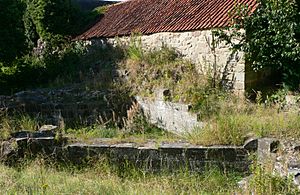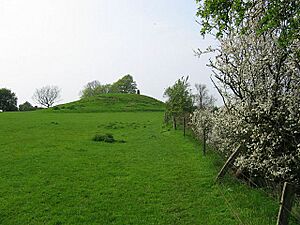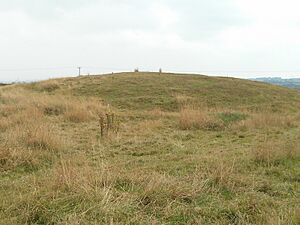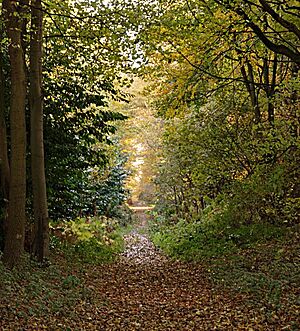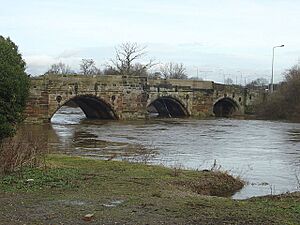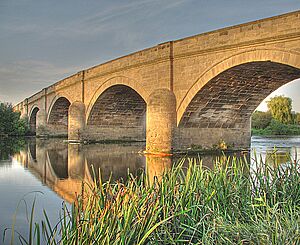Scheduled monuments in South Derbyshire facts for kids
Did you know that some of the oldest and most important places in England are protected by law? These special spots are called scheduled monuments. They could be anything from ancient castles to old burial mounds or even parts of old villages.
In the United Kingdom, a scheduled monument is a really important archaeological site or historic building. It's given special protection to make sure it doesn't get damaged without permission. The Secretary of State for Culture, Media and Sport is the person who puts these places on a special list. An organisation called English Heritage helps find and protect these sites. There are about 20,000 scheduled monuments across the country!
Derbyshire, the county where South Derbyshire is located, has over 500 of these amazing scheduled monuments. They include many stone piles (called cairns), stone circles, ancient burial mounds (barrows), old lead mining sites, and even more than 20 historic bridges.
Contents
What are Scheduled Monuments?
Scheduled monuments are like national treasures from the past. They are protected because they teach us so much about how people lived long ago. Imagine finding a piece of history that's thousands of years old! These sites help archaeologists and historians understand ancient cultures and events.
English Heritage plays a big role in looking after these places. They make sure that any changes to a scheduled monument are carefully planned and approved. This helps keep these important parts of our history safe for everyone to learn from and enjoy.
Discovering South Derbyshire's Ancient Treasures
South Derbyshire is home to many fascinating scheduled monuments. Let's explore some of these amazing places and what makes them special.
Castles and Forts
South Derbyshire has remains of old castles and forts that tell tales of knights and ancient battles.
Bretby Castle
At Bretby, you can find the remains of a fortified manor. This was a large house, almost like a small castle, built between the 13th and 17th centuries. It had banks and ditches around it for defence, showing it was a strong and important place long ago.
Castle Gresley Motte and Bailey
Near Castle Gresley, there are the remains of a motte and bailey castle. This type of castle was popular after the Norman Conquest. It had a large mound (the motte) with a wooden tower on top, and a walled courtyard (the bailey) below. These were often quick to build but very effective for defence.
Melbourne Castle
Melbourne Castle is a medieval castle built on the site of an even older royal manor house. Construction started in 1311 during the time of King John and continued for about 11 years, but it was never fully finished. Even as ruins, it's a powerful reminder of medieval times.
Walton upon Trent Hillfort
Near Walton upon Trent, there's a slight univallate hillfort. A hillfort is an ancient fort built on a hill, often surrounded by one (univallate) or more earthworks like ditches and banks. These were used by people in the Iron Age for protection and as important community centres.
Ancient Settlements and Villages
These sites show us where people lived, worked, and built their communities centuries ago.
Barton Blount Medieval Village
North of Barton Hall, you can find the remains of a medieval settlement. This includes traces of an old chapel, a special pond used for hunting ducks (a decoy pond), and parts of the old open field system where villagers grew their crops. It gives us a glimpse into daily life in the Middle Ages.
Iron Age Settlement near Aston-on-Trent
Southeast of Aston-on-Trent, there's an Iron Age settlement and a cursus. An Iron Age settlement was a village or group of homes from around 800 BC to AD 100. A cursus is a very long, narrow, rectangular earthwork that archaeologists believe was used for ceremonies or processions.
Shrunken Medieval Village at Thurvaston
In Osleston and Thurvaston, there are remains of a shrunken medieval village and a moated site. A shrunken village is one that became much smaller over time, often leaving behind the outlines of old buildings and roads. A moated site is where a building, like a manor house, was surrounded by a ditch filled with water for defence or show.
Mysterious Burial Mounds and Circles
These ancient sites often hold secrets about how people honoured their dead and performed rituals.
Hoon Mount Barrow
Hoon Mount is a platformed bowl barrow. A barrow is an ancient burial mound, often shaped like a bowl. These were used to bury people, sometimes with their belongings, thousands of years ago.
Swarkestone Lows Barrow Cemetery
North-west of The Lowes Farm, you'll find the Swarkestone Lows round barrow cemetery. A barrow cemetery means there are several burial mounds grouped together. This site also includes part of an ancient field system, showing how people used the land around their burial places.
Twyford Henge and Round Hill Barrow
Twyford is home to a henge and the Round Hill bowl barrow. A henge is a type of circular earthwork, often with a ditch inside a bank, that was used for ceremonies in prehistoric times. The bowl barrow is another ancient burial mound.
Viking Barrow Cemetery at Heath Wood
Heath Wood, near Ingleby, has a very special Viking barrow cemetery. It contains 59 burial mounds, and it's the only known Scandinavian cremation site in the British Isles! This means Vikings who settled here cremated their dead and buried their ashes in these mounds. It's a unique link to Viking history in England.
Historic Bridges and Other Structures
Not all monuments are ancient; some are important historical buildings or structures from more recent times.
Calke Park Tunnel
At Ticknall, there's the Calke Park Tunnel. Tunnels like this were often built for estates to allow roads or paths to pass under them, or sometimes for canals or railways. This one is part of the historic Calke Abbey estate.
Dovecote at Netherseal
South of Netherseal Old Hall, you can find an old dovecote. A dovecote is a building designed to house pigeons or doves. In medieval times, they were important for providing meat and eggs, especially during winter. This dovecote is also a Grade II* listed building, meaning it's of special interest.
Monks Bridge
Monks Bridge is a historic bridge located in Egginton. Old bridges are important because they show us how people travelled and traded in the past, and how they built structures to cross rivers and obstacles.
Swarkestone Bridge
Swarkestone Bridge is a famous medieval bridge that crosses the River Trent between the villages of Swarkestone and Stanton. It's a very long and old bridge, and it's also a Grade I listed building, meaning it's of exceptional interest. It has seen centuries of history pass over its stones.
Medieval Church and Cross near Ticknall
Near St George's Church in Ticknall, there are the remains of a medieval church and cross. These sites often mark important religious places from the Middle Ages, showing where communities gathered for worship and ceremonies.
Henge Complex NW of Hickens Bridge
In Shardlow and Great Wilne, there's a henge complex. This means there are several henges or related earthworks in one area. These complexes were significant gathering places for prehistoric people, possibly for religious or social events.
Heavy Anti-aircraft Gunsite
Southeast of Gardens Farm in Elvaston, you can find a Heavy Anti-aircraft gunsite. This is a military site from more recent history, likely from World War II. These sites were used to defend against enemy aircraft, showing how important this area was during wartime.
|


